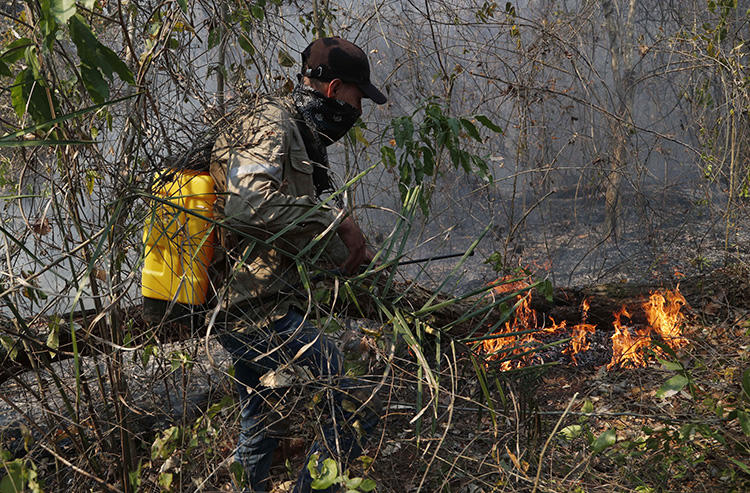When Pablo Ortiz, a veteran reporter for El Deber, the main daily in the eastern city of Santa Cruz, set off to cover massive forest fires, he didn’t realize how dangerous the assignment would be.
At one point Ortiz was alongside volunteer firefighters as shifting winds began moving the flames around. To avoid being hemmed in by the fire and choked by smoke, the group quickly retreated as burning trees came crashing down around them.
The fires in Bolivia, which according to official estimates have caused nearly as much destruction as those in neighboring Brazil, have posed enormous challenges for Bolivia’s news media.
Journalists told CPJ that they receive no advance training on how to safely cover the fires and often have to buy their own protective clothing. Adding to the danger, many end up following inexperienced firefighters into the affected areas. Meanwhile, their efforts to provide a clear picture of the tragedy are often muddied by government officials who, with an eye on next month’s presidential election, are downplaying the extent of the fire damage.
“Everyone is underestimating just how bad these fires are,” Ortiz told CPJ in a recent interview in Santa Cruz.
Officials say the fires, most of which have broken out in the Chiquitano, a dry tropical forest near the Brazilian border, have burned more than 6 million acres. The international media have largely ignored the disaster, in part because they have focused much of their attention on fires in the Brazilian Amazon. However, the fires have dominated the news in Bolivia for the past two months.
Romaneth Hidalgo, news director for the private Santa Cruz cable station Full TV, said journalists often embed with volunteer firefighters who have flooded into eastern Bolivia. But like the reporters, these volunteers often lack training or much on-the-ground experience dealing with major fires. Journalists, she added, often arrive without helmets, respirators, or protective boots.
“I saw one guy reporting on the fires in shorts,” Hidalgo told CPJ.
The risks were evident when a CPJ correspondent accompanied a group of six volunteers to a fire blazing in the Chiquitano forest near the town of Concepción. The firefighters carried rakes, shovels, and water tanks on their backs. But they lacked enough water and manpower to douse or contain the flames. As the wind picked up, the fire intensified and spread. Visibly nervous, the volunteers broke into a trot as they evacuated, urging the CPJ correspondent to follow them.
So far no reporters have been injured or killed while covering the fires, but government officials say that five volunteer firefighters have died.
Beyond the physical danger, Hidalgo said that one of the biggest challenges is providing the public with an accurate picture of the fires amid a barrage of government propaganda.
The fires broke out shortly before President Evo Morales launched his campaign for a fourth consecutive term in the October 20 election. To avoid a backlash at the polls, Hidalgo said that government ministers routinely downplay the extent of the fires — a job is made easier by the pro-government TV and radio stations that dominate the airwaves.
José Zapata, a firefighter who has been working in the Chiquitano forest for the past two months, said that when the news media repeat erroneous declarations that the fires are under control, donations of badly needed food and equipment for the firefighters start to dry up.
“There is a lot of disinformation,” Zapata told CPJ. “Every day we have to deal with more fires. This is the worst I’ve ever seen.”
Even before the fires broke out, media coverage of the environment had been spotty, said Isabel Mercado, editor of the independent La Paz daily Página Siete. She told CPJ that few journalists specialize in “green” issues, while ecological groups have been harassed by the Morales government.
In 2013 a Danish nongovernmental organization (NGO) called IBIS that dealt with climate change issues was expelled from the country. Two years later, Vice President Álvaro García Linera threatened to shut down four more NGOs that had criticized the government’s land-use policies. As a result, Mercado said, environmental groups that in the past provided story ideas, tips, and context to reporters are keeping a low profile.
Hard-hitting reporting has also been hampered by the government’s expanding control over the major news media in Bolivia, said Raúl Peñaranda, editor of the Brújula Digital news website. He said nearly all private TV and radio stations plus a growing number of newspapers are friendly toward the government and rarely delve into its efforts to expand logging and cattle ranching in the Bolivian Amazon and Chiquitano forests.
Among the tactics used by the government, according to Peñaranda and CPJ reporting, are threats to withhold state advertising from critical news outlets, filing lawsuits against critical reporters, and lobbying businesspeople friendly toward the government to buy formerly independent media outlets.
Government officials did not respond to numerous requests by CPJ for comment sent via messaging app.
Ortiz, of El Deber, insists that there has been some stellar reporting in the Bolivian media, including a series by his newspaper about the illegal trafficking of jaguar fangs that in January won a prestigious Rey de España journalism award in Spain.
But he admits that much of the current coverage of the fires has focused on their aftermath while glossing over factors that may have helped cause them.
For example, many government critics attribute the rising number of fires this year, in part, to a law that increased by four-fold the amount of land that individual farmers are allowed to clear and burn to make room for crops and livestock. Rafael Loyaza, dean of the communications faculty at the Catholic University of Bolivia in La Paz, points out that there were very few stories about the law when it was passed by Bolivia’s congress in 2015.
He told CPJ: “There was almost no coverage.”
[Reporting from La Paz, Santa Cruz, and Concepción, Bolivia]
